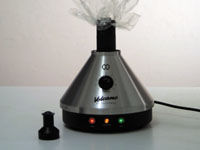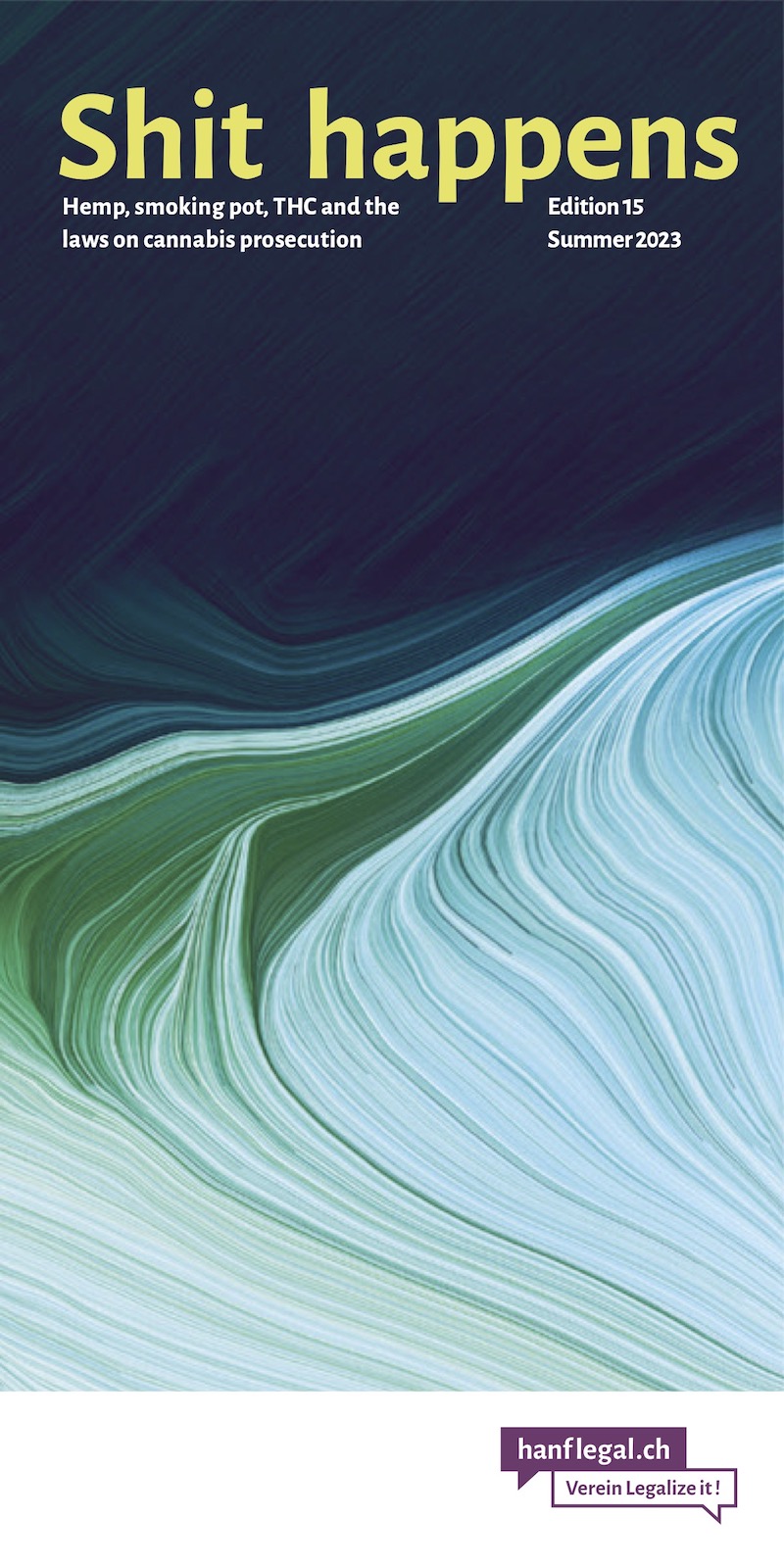- THC & Law:
How stable is the Volcano vaporizer?
The University of Leiden in Holland conducted a vaporizer study. It is the second major study on the Volcano, which we also consider to be the most sophisticated vaporizer machine at the moment. We summarize the results in our article.
Initial question of the study
THC and other cannabinoids can be extremely helpful for many diseases. What is lacking, however, is a fast, reliable way to deliver THC to patients - and without smoke. Eating, i.e. oral intake, is possible, but the effects are difficult to assess. After all, THC is fat-soluble and is absorbed faster or slower depending on other stomach contents. This leads to unreliable absorption. Through the lungs, however, absorption is much more predictable, the effects occur more quickly, and thus the amount of active substance can be well controlled by the patients themselves. Smoking, however, is not an option for health purposes - too many toxins are produced and enter the body. Vaporization is the order of the day here, and the Leiden University study examined the Volcano from the Storz&Bickel company in Tuttlingen, Germany. We have reported several times on vaporization technology and also on the Volcano (see Legalize it! issues 27, 28, 30, 31, 36). There you will also find information about the exact functioning of the Volcano. These facilitate the understanding of this article! The aim of the study was to find out whether the Volcano is a reliable tool for the delivery of THC. The study did not primarily use hash or weed, but predominantly used a standardized, pure THC solution to be sure that the source material would not influence the study results.
The research topics at a glance
However, all sorts of other things were changed: The Volcano was tested at different heat settings and with different balloon sizes. Furthermore, it was seen how much THC condensed on parts of the device (and thus could not be collected by the balloon), how long the THC vapors remained consumable in the balloon. They also looked to see if four different Volcano devices differed from each other, or if individual devices produced the same results in different trials. Finally, the researchers were interested in how much THC was exhaled after ingestion. All trials were conducted three times. Dutch medicinal female hemp flowers with a THC acid content of 12% were used to produce 98% pure THC or pure THC acid.
Temperature accuracy
The settings 1 (130°), 3 (154°), 5 (178°), 7 (202°) and 9 (226°) on the Volcano were tested. It was found that after about 30 to 40 seconds of air supply (green switch on the Volcano), the temperature in the filling chamber reached close to the set temperature as indicated above. Then it dropped again by a few degrees and then rose to the set temperature. In summary, the Volcano is very stable at temperature (+/- 4 degrees around the target temperature), but only after the heating lamp has gone out and warm air has then been supplied for about half a minute.
Differences between different volcanos
Four Volcanos were compared with each other. The researchers found that three devices were fairly close to the predicted temperature range, but one remained a few degrees above the target range even after 90 seconds. To summarize: A Volcano stays very true to itself - one temperature setting will produce the same results over and over again. But there are somewhat larger differences between Volcanos, which means that you can't simply make a setting on one unit (for example, 7.5) produce exactly the same temperature on a second unit. There can be deviations of up to seven degrees (which, however, does not have a great impact on the result when vaporizing). For this reason, the Volcano is not labeled with absolute temperature values, but with numbers from one to nine. However, the exact temperature in the filling chamber can be measured very precisely with a thermometer with temperature sensor (cost: about 100 francs) (in the Legalize it!-office we have such a device - who is interested in it, please feel free to contact us).
Conversion of THC acid to THC
Especially in fresh plant material there is no (psychoactive) THC, but THC acid is present (which is not psychoactive). With heat or during storage of weed this acid part is then split off and THC acid becomes THC. The researchers vaporized pure THC acid in Volcano, with a 33% yield at step nine. The evaporation heat split off a large portion of the acid, but some THC acid remained. The researchers then tried fresh female hemp flowers and again achieved a yield of around 29%. In addition, the meters found many other cannabinoids in vapor, as well as other plant material (for example, essential oils). When using pure THC, the yield then increased to about 53%, whereby the vapor in this case consisted exclusively of THC - not a single other substance was found, not even a degradation product of THC (such as cannabinol or delta-8-THC).
On the efficiency of the Volcano
Practically all of the original solution filled in was vaporized - so the question arises as to where the missing percent THC went? Since only small amounts (around two percent in normal use) of condensed THC could be found in the balloon as well, the THC seems to condense on the way between the filling chamber and the balloon. This is also noticeable when cleaning the Volcano (which makes sense about every half year): A sticky hash layer of condensed THC forms on these parts (which can of course be reused if one wishes). The researchers found here a condensation of almost 25% of the filled THC.
The best setting of the Volcano
Again about the temperatures: No matter if THC acid, THC or female hemp flowers: The best yield could be measured at the highest temperature setting (nine). For the plant material, the yield was as follows:
- Temperature 9: About 30%
- Temperature 7: About 10%
- Temperature 5: About 3%
- Temperature 3: Around 0%
- Temperature 1: Around 0%
This shows that THC vaporizes efficiently only at temperatures above 200 degrees - however, one can also see that at setting seven or eight, quite a bit of THC-vapor is already produced. Care must be taken to fill the balloon for at least 45 seconds (or preheat the filling chamber for half a minute), and after 120 seconds practically all THC seems to have evaporated (this can of course be divided into several balloons).
The efficiency with pure THC
So at level nine, you can detect a little over 50% of the filled THC in the vapor. If about half of the filled THC enters the balloon and about a quarter condenses on the way there, then about a quarter remains, of which it is not known exactly where it is lost (an unknown part escapes through cracks between the individual components). The study does not provide any more detailed information on this.
The data on the balloon
Once the THC is in the balloon - how long does it stay in the vapor phase before it condenses on the balloon? The tests show that it remains vaporous for a surprisingly long time: After half an hour, 75% of the original THC is still in the balloon; after an hour, just under 60%; and after three hours, 10%. (From practical experience, however, it must be added that the vapor deteriorates much faster in taste and a balloon should be emptied after just a few minutes).
How much THC can the lungs absorb?
Then the researchers investigated how much THC the lungs could absorb from the vapor. 20mg of THC was vaporized for each subject, of which around 10.8mg entered the balloon in vapor form and was inhaled. When exhaled, between 2.5 and 4.4mg was exhaled again. Thus, 30 to 40% of the ingested THC was blown out again. (This was while holding the breath for 10 seconds after inhalation.) In summary, a charge of the Volcano with 20mg of THC resulted in an effective uptake of 6 to 8mg for each subject. According to the study, this is a similar level to that achieved by smoking.
Conclusions of the study and of us
The researchers found some variability in evaporation because the Volcano does not keep the temperature exact, but stable within a range of about 8 degrees - this variability probably explains the up to 15% differences between individual evaporation events. So, clinically, the Volcano is not perfect, but the stability is still very great. The highest temperature setting seems to be the most efficient, then over 50% of the filled pure THC is transported into the balloon. THC acid does not do as well, pure THC vaporizes better than plant material. At weed, many plant compounds can be found in vapor, so from a clinical perspective, researchers prefer to work with pure THC (or perhaps in later studies, mixtures of pure cannabinoids) where only THC and nothing else is found in the balloon. However, besides THC and THC relatives, these plant substances seem to be mainly the essential oils, which are terpenoids. These are harmless, only a slight irritation of the throat and lungs are caused by these substances (as with many other essential oils). In comparison to smoking, the study states that in smoking studies about 34 to 69% percent of the THC present was carried into the lungs - with Volcano you are also in this range. Questions remain here: subjectively, all Volcano users report a massively higher yield of psychoactive effects when inhaling compared to smoking. This study cannot answer why this is so. On the other hand, it is very encouraging that there are already two large studies on the Volcano and that further institutes will probably deal with this device. Even if the Volcano still has a potential to become more accurate and “more and more similar”, it is the device with which one can produce very similar results over and over again. And that is essential for scientific studies or a clinical use. All other vaporizers (we are not talking about the devices that don't work at all!) have a much wider range of results. With all devices, where the inhalation determines the heat flow, very different results are obtained depending on the type of drawing, because the temperatures do not vary by +/- 4 degrees, but in the range of +/- 50 degrees. This makes it very difficult to study such devices scientifically.
Smoking soon banned?
Smoking is blowing a corrosive social wind. And now, in 2008, what has already been implemented in Italy could become reality in Switzerland: smoke is to disappear from all buildings where people go to work. With parliamentary initiative 04.476, National Councilor Felix Gutzwiller demanded two years ago: “The population and the economy will be protected from the harmful and restrictive effects of passive smoking. (…) This will ensure protection from passive smoking, especially in educational and health institutions, in public administration, in workplaces and in rooms and means of transport intended for free access or use by the general public.” In September 2006, the National Council's Commission for Social Security and Health sent the proposed amendment to the Labor Code for consultation. The new Article 6(2ter) would read, “Workplaces are smoke-free. The employer shall protect employees from passive smoking while carrying out their work activities. The Federal Council shall issue the implementing provisions.” Smoking as a form of consumption no longer satisfies society's health demands, so bans and tax increases are used to try to dissuade people from consuming it. Another approach would not be to abstain, but to find an alternative form of consumption that allows for more harmless consumption. In the course of time, addictive and stimulant substances have never been eliminated by bans, but the forms of consumption have changed, in some cases extremely. We believe the future belongs to vaporize!
Support our work with a donation:
Bank transfer
Account number (IBAN):
CH02 0900 0000 8709 1354 3
Full account details
Or scan this QR code with your eBanking App (ZKB, Revolut, Postfinance, …):

Or open/share the QR code as PDF file with your eBanking App.
Credit card
Donate via credit card
Verein Legalize it!
Quellenstrasse 25
8005 Zürich
Threema ID 7NH65RBY
Don’t miss anything! Follow us on social media:

